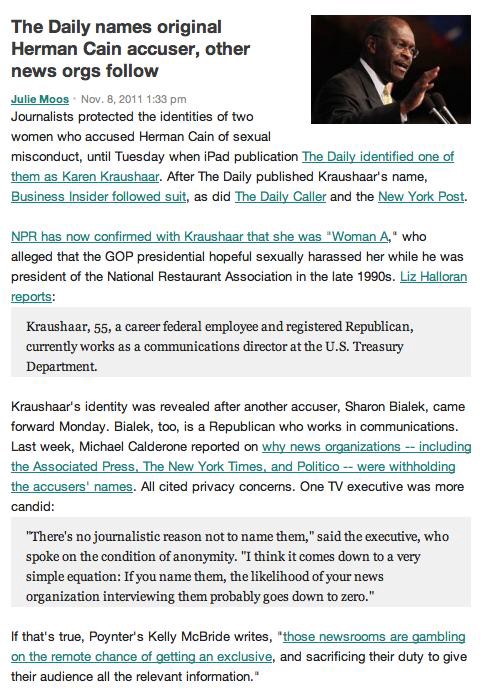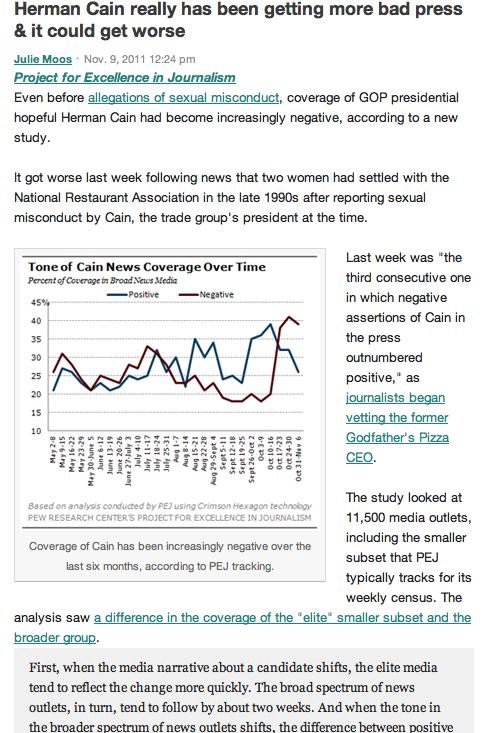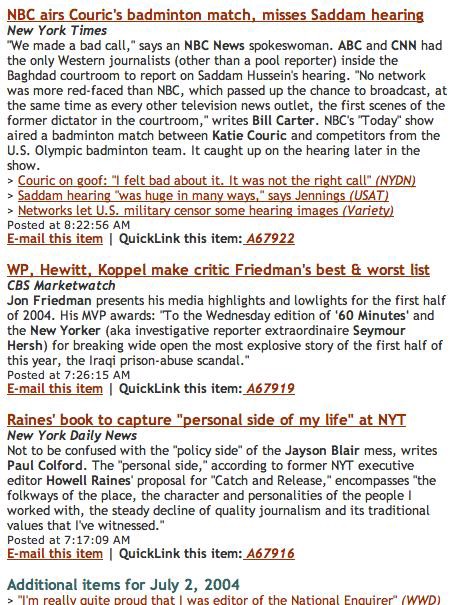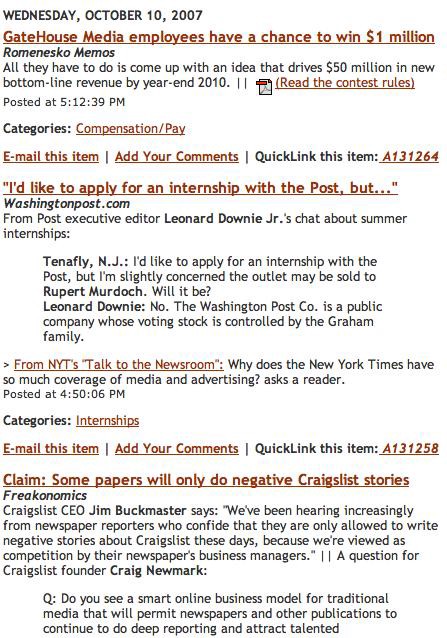The Intolerable Evolution of Poynter's "Romenesko+"
The “Romenesko” blog (launched in 1999!) was a one-man shop, under the corporate parentage of the Poynter Institute, until fairly recently. It was quite successfully run by its founder, Jim Romenesko, though you could tell every once in a while he’d go through periods of advanced boredom in covering media day-in and day-out. People (well, reporters and editors) mostly loved it; the headlines were, unusually, out-bound links. So it sent traffic. Romenesko’s slight summaries were careful and sometimes sly. The “technology” of the site as such was pretty laughable, down to the ridiculous URL. He was super-fast, he was fair and he was, very subtly, often dryly funny. Then Poynter got whorey.
The headlines became permalinks to the site itself, so it stopped sending much traffic. The site became more “social” in orientation. The posts got longer. More Poynter-as-newspaper-sherpa crap crept in (“How will you handle graphic images or video of Gadhafi’s death?” Zzzz). Two years ago, Julie Moos, who’s been with Poynter for ten years, got her latest promotion and is now the big boss of publishing at Poynter. I have no idea what she’s like, possibly wonderful, but as a blogger and writer, she’s ham-fisted, at best, to my ear. The changes at the blog have been awful to watch. Let’s take a look at the new way things are done at Poynter’s blog — semi-rebranded as “Romenesko+,” which, let’s just pretend that didn’t happen.

And:

This is what it used to be like.


The site has grown increasingly more intolerable. Romensko himself is set to retire permanently from the site (for more interesting ventures) very shortly. And today Julie Moos dropped the bombshell: “I now know that Jim Romenesko’s posts exhibit a pattern of incomplete attribution.” Much handwringing follows; in some blog posts, “the words may appear to belong to Jim when they in fact belong to another.” (Can they “may,” really?) Romenesko offered to resign (ahead of schedule); she refused his resignation. (And he really should tell them to stuff it, but not if it hurts his retirement package in any way.) She concludes: “We are in uncharted territory, marked by uncertainty, which suggests caution. We will continue to evaluate this situation and to be as transparent as possible about what we learn and decide.” (Great, prolong this.) And: “To our knowledge no writer or publication has ever told us their words were being co-opted,” she writes. To my knowledge, no writer has ever, ever complained or even thought to complain about Romenesko, and I certainly have spent a strangely large amount of time talking about him over the last decade. (I have exchanged a few emails with him, barely, over the years.)
Romenesko’s entire practice was about giving credit, in ways that virtually no other blog has been, a position that “Romenesko+” does not embrace as strongly. Poynter has worked systematically to erode a fairly noble, not particularly money-making thing as it works to boost “engagement” and whatever other (highly transitional!) web “best practices” are being touted at the heinous “online journalism” conferences that regularly go on. Charitable with links and naming bylines, and producing even more links when grubby reporters would come emailing with “but I posted that memo just now tooooo!”, the intention underlying Romenesko’s work has always been directing readers to reported material.
To be fair to Moos, though I don’t particularly care, in her position I don’t think she has any choice but to publish about this. It’s the sort of media “process” stuff that is Poynter’s bread and butter (along with initiatives like “Writing Better Headlines and SEO Essentials,” an online class you can take in February!). Moos is also too coy. She learned of all this “thanks to the sharp eye of Erika Fry, an assistant editor at the Columbia Journalism Review.” What she meant was that Fry is working on a story about Romenesko and attribution, and so Moos went to publish first. I found that attribution a little incomplete.
